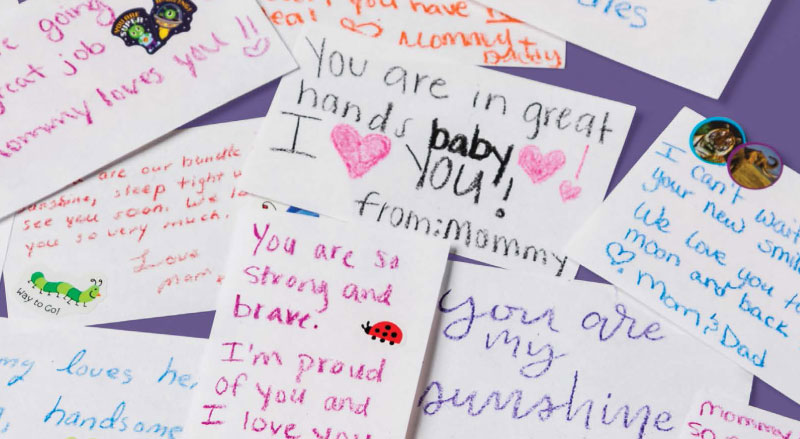When Jenna Allison, M.D., spends time at Children’s Nebraska, she enjoys watching medicine being delivered first-hand and discussing notable exam findings with faculty. She’s a big fan of playing Medical Jeopardy and “Name that Syndrome.”
While the vast majority of community members experience Children’s solely as a clinical facility, for Dr. Allison, it serves as an interactive classroom and training ground.
A pediatric resident studying at University of Nebraska Medical Center College of Medicine, Dr Allison is far from alone. As the only academic institution dedicated to pediatrics in the region, Children’s attracts around 2,000 learners annually. This includes medical, allied health, nursing and all other ancillary students.
“The programs that train the next generation of health care providers need to have access to excellent clinical facilities like Children’s, so that future caregivers can learn how to take care of kids,” says John W. Sparks M.D., Children’s pediatrician-in-chief and chair of the department of Pediatrics at UNMC. “We serve a critical function in ensuring that—not only here in Omaha, but across the state and beyond—children have access to people who are specially trained in caring for them. We take that very seriously.”
“They’re not leaving here as individuals, but as part of a team.”
—Russell Buzalko, PH.D., Children’s director of Medical Education
Children’s partners closely with Creighton University School of Medicine, UNMC College of Medicine and Nebraska Medicine for medical education, as well as 12 nursing schools. In total, the teaching hospital welcomes learners from nearly 35 different education institutions and employers. This includes interns, residents, fellows and current staff obtaining continuing education.
“Education is one of four fundamental pillars here at Children’s, standing alongside clinical care, research and advocacy,” explains Dr. Sparks. “We’re committed to making sure we have an environment that nurtures and supports all of our trainees, faculty and staff.”
The creation of Children’s new Office of Education is tangible proof of that commitment. It launched this fall to improve the learner and faculty experience, enhance teaching methods and innovations and provide standardization and support to departments.
“In the past, student management was done in silos,” explains Russell Buzalko, Ph.D., Children’s new director of Medical Education. Individual departments and offices were tracking student information on large spreadsheets with little integration, making it difficult to see the big picture. Today, Children’s is moving toward an online, integrated student management system, where comprehensive learner data is available 24/7 in one place. More coordinated data will mean a more seamless learner experience and greater opportunity for program evaluation and improvement.
“The purpose of the Office of Education is to take our education endeavors to the next level, to take everything into the next generation,” says Dr. Buzalko.
That’s important to students like Dr Allison, who crave educational experiences outside the lecture hall and far beyond the Socratic Method. She expects learning that’s “fun, innovative and applicable.”
“Millennials are more high-tech and on-demand; they want to learn in a way that’s hands-on and experiential,” Dr. Buzalko says. “In response to that change in learning style, some medical schools are integrating clinical experience—at the bedside with patients and providers—earlier in the process than ever before.”
He adds, “In the years to come, we’re going to increasingly focus on simulation training because we know it is much more effective in terms of retention and maintenance of skills.”
Another emphasis in the here and now—and on the horizon—is the importance of teamwork.
“Medicine is a team concept. With so many disciplines and departments, learners need to know how to work well with others. They’re not leaving here as individuals, but as part of a team,” says Dr. Buzalko. Inter-professional education and working in small group environments will be more commonplace.
The future of education at Children’s goes beyond the individual and beyond borders. As the hospital aspires to be a global leader for children’s health, its educational efforts and affiliations are branching out across the world. Children’s is connected to roughly 30 different countries through international academic collaborations
“We’re continually developing relationships with global academic partners—from central Europe, China, Rwanda, Vietnam, the Dominican Republic,” shares Dr. Buzalko. “We have trainees from many different countries that are already part of our system, and we’re looking to expand those collaborative relationships so we can have an even greater global impact on children’s health.”
Dr. Sparks points out that it’s a two-way street, as “their learners want to come here and see what great American medicine looks like, and many of our learners want to go abroad to gain experiences in global health care.” He adds that many Children’s faculty members travel internationally to train the next generation of caregivers in other parts of the world, as well. “We can’t do things in isolation; we’re better together.”
As schools and teaching hospitals reimagine how students will be best trained in the future—quite literally, rewriting the book and redrawing the map—Dr. Sparks emphasizes that the heart and the humanity of the work remains the same.
“There’s no substitute for learning from other experts in the field. They model for the students the essential, unchanging skills—how do I talk to a child, how do I do a physical exam, how do I interact with parents. And, ultimately, we’re all here because we want the very best outcome and experience for the patients and families we serve.”
That patient-first focus isn’t just a sound bite or feel-good philosophy; it’s a way of life, according to Dr. Allison, who has witnessed it first-hand in her residency.
“One thing that has always stuck out to me about Children’s is that the teaching is always patient-centered,” she says. “Education is provided in a way to not only make me a better physician, but most importantly to take the best possible care of the patients.”
Her words are music to the ears of leaders like Dr. Buzalko, who readily notes that education efforts can have a direct impact on recruiting success.
“If they receive an exceptional experience here as a learner, they’re more likely to stay on board with us as an employee,” he says. “We love to welcome learners back into our family as staff members.”
“We frequently recruit from outside the Omaha area, but we understand the need to grow our own,” says Dr. Sparks. “The goal is to elevate the standard of care here in Nebraska. It’s incredibly satisfying when I go out in the community and see people who trained here doing a great job caring for kids. Even a general surgeon out in Scottsbluff needs those core skills in pediatrics that we teach to do his or her job well.”
Whether Dr. Allison ends up practicing medicine in Omaha or abroad, Dr. Sparks says education is Children’s way of passing the torch of quality pediatric care to the next generation, paying it forward to benefit the children of tomorrow.
He adds, “I can care for one child and do a great job, and make a difference in that child’s life; but if I can train others and make sure the next generation of caregiver is knowledgeable and skillful, then I’m impacting countless children, and I know the future is in good hands.”



